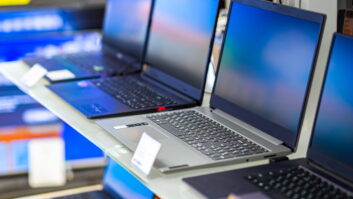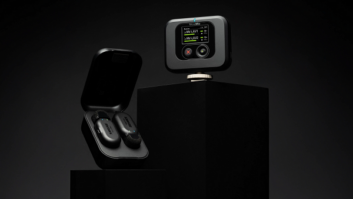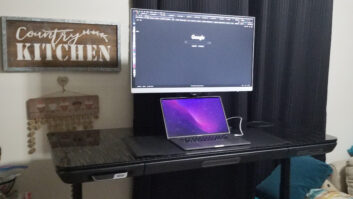New York – Motorola and Verizon Wireless are bringing back the Razr name for use on the industry’s thinnest smartphone at 7.1mm in depth.
The $299 Droid Razr by Motorola, part of Verizon’s exclusive Droid-branded Android phone selection, will be available in November before Thanksgiving at $299 in Verizon’s direct and indirect channels. It’s available for preorder on Oct. 27. It will be one of several new 4G phones that Verizon will launch in the fourth quarter, a spokesperson told TWICE.
In the 2000s, the Razr name appeared on a series of highly successful Motorola phones that were the industry’s thinnest at the time. The series catapulted Motorola sales to heights that have not been duplicated since.
The Droid Razr’s 7.1mm depth compares with the iPhone 4S’s 9.3mm depth and the 8.9mm depth of Samsung’s Galaxy S Class Android phone for AT&T.
In a separate announcement, Motorola launched a non-cellular product, the wearable Motoactv MP3 player/fitness tracker with GPS.
Though thin, Droid Razr was designed to be rugged enough to place in a back pocket without fear of breakage, said Motorola chief marketing officer Bill Ogle. For ruggedness, the phone features interior stainless-steel core, and the exterior features laser-cut Kevlar-fiber chassis for strength and lightness. The display is made from Corning Gorilla Glass to prevent scratches.
The phone, one of the industry’s lightest at 126 grams, is also Motorola’s first with Splashguard nano technology to protect it against moisture.
The phone will be marketed in TV, web, and print ads as faster, thinner, smarter and stronger, Ogle said. Teaser ads will begin appearing at the end of October before the full campaign is launched, he said.
With its dual-core 1.2GHz processor, the Droid Razr offers the fastest processing speed of any of the six other 4G handsets currently offered by Verizon. The Razr processor is also faster than new iPhone 4S’s dual-core 1GHz processor.
For Motorola, the Droid Razr features a faster processor than any of the company’s other phones and matches the dual-core 1.2GHz speed of the Samsung Galaxy S II for AT&T and Sprint. The T-Mobile version of the Galaxy S II, however, features a dual-core 1.5GHz processor.
To enhance processing speed, the Droid Razr also features 1GB of RAM.
Other key features include 4.3-inch advanced-qHD Super AMOLED display, which is said to offer more contrast and color saturation than the iPhone 4S. Other features include 8-megapixel rear camera with 1080p 30fps video capture, 1.3-megapixel front camera, 16GB of embedded memory, included 16GB MicroSD card and Android 2.3 OS.
The Droid Razr is also the first phone in the U.S. to stream Netflix in HD, Motorola said. Netflix can be streamed over Wi-Fi or 4G but not over 3G. The Netflix app also features copy-protection technology to enable it to stream over an HDMI cable to a connected TV.
The phone is promoted as “smarter” because of such key features as “smart actions” software that extends battery life by up to 30 percent using such means as slowing data and processor speeds when battery life drops below 20 percent. Battery life is promoted at 12.5 hours of 3G talk time and 8.9 hours of video playback on its 1780 mAh battery. Battery life for 4G data usage wasn’t disclosed.
Other smarter features include a personal Cloud storage solution called MotoCast. Via MotoCast software on a PC and the phone’s MotoCast app, users can stream or download photos, music files, and document files from the PC to their phone. Pictures taken by the phone are also automatically synced with the PC.
Motorola also bills the Razr as smarter because of an array of enterprise-friendly features that will enable consumers to use their personal phone to access corporate email, calendar and contacts. The features include government-grade encryption, remote wipe, password enforcement and PIN locking. Also for corporate use, the phone comes with Quick Office to edit and create Microsoft Office documents, Citrix, Go To Meeting and video conferencing via webcam.
The phone, like other Motorola 4G phones, connects to a pair of laptop-looking Lapdock accessories that let users view smartphone content on a larger screen and surf the web via 4G using a Mozillla Firefox browser.
The phone lacks 2.1GHz-band cellular for use in foreign markets, so it’s not classified as a global phone, though its 3G 850/1900MHz technology operates in some foreign countries.
The phone will be launched in other global markets next month as the Motorola Razr.
In launching the wearable Motoactv MP3 player/fitness tracker, Motorola announced Nov. 6 in-store availability of the 8GB version at $249 and the 16GB version at $299. They can be worn on a wristband or armband and feature small 1.6-inch-square capacitive touchscreen.
Both versions track such performance stats as time, distance, speed and calories burned. They also track heart rate via a new stereo Bluetooth headset and a new wired headset, both with embedded biometric sensors to make a separate monitor unnecessary. They retail for a suggested $149 and $99, respectively.
Both MP3/fitness trackers also feature FM radio and display caller ID and text messages from a Bluetooth-connected cellphone.
The devices also automatically sync via Wi-Fi to a PC to upload stats to the Motoactv.com website for viewing a workout analysis and view routes taken.
The fitness trackers will be in Best Buy, Amazon Sports Authority, Eastern Mountain Sports and REI on Nov. 6, with additional retailers following. They’ll also be available in Verizon-owned stores in November.
The only other non-cellular product offered by Motorola in recent years, excluding cellular accessories such as headsets, has been portable navigation devices in 2008. They’re no longer in production.













